Oriented asymmetric divisions that generate the stomatal spacing pattern in arabidopsis are disrupted by the too many mouths mutation
- PMID: 11090210
- PMCID: PMC150159
- DOI: 10.1105/tpc.12.11.2075
Oriented asymmetric divisions that generate the stomatal spacing pattern in arabidopsis are disrupted by the too many mouths mutation
Abstract
Wild-type stomata are spaced by intervening cells, a pattern disrupted in the Arabidopsis mutant too many mouths (tmm). To determine the mechanism of wild-type spacing and how tmm results in pattern violations, we analyzed the behavior of cells through time by using sequential dental resin impressions. Meristemoids are stomatal precursors produced by asymmetric division. We show that wild-type patterning largely results when divisions next to a preexisting stoma or precursor are oriented so that the new meristemoid is placed away. Because this placement is independent of cell lineage, these divisions may be oriented by cell-cell signaling. tmm randomizes this orientation and releases a prohibition on asymmetric division in cells at specific locations, resulting in stomatal clusters. TMM is thus necessary for two position-dependent events in leaves: the orientation of asymmetric divisions that pattern stomata, and the control of which cells will enter the stomatal pathway. In addition, our findings argue against most previous hypotheses of wild-type stomatal patterning.
Figures


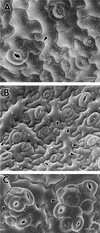

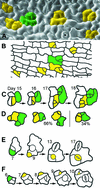
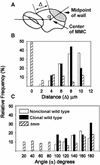

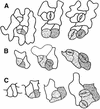

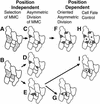

Similar articles
-
TOO MANY MOUTHS promotes cell fate progression in stomatal development of Arabidopsis stems.Planta. 2009 Jan;229(2):357-67. doi: 10.1007/s00425-008-0835-9. Epub 2008 Nov 1. Planta. 2009. PMID: 18979118
-
A new loss-of-function allele 28y reveals a role of ARGONAUTE1 in limiting asymmetric division of stomatal lineage ground cell.J Integr Plant Biol. 2014 Jun;56(6):539-49. doi: 10.1111/jipb.12154. Epub 2014 Mar 6. J Integr Plant Biol. 2014. PMID: 24386951
-
Ultrastructure and development of non-contiguous stomatal clusters and helicocytic patterning in Begonia.Ann Bot. 2018 Nov 3;122(5):767-776. doi: 10.1093/aob/mcx146. Ann Bot. 2018. PMID: 29186307 Free PMC article.
-
Take a deep breath: peptide signalling in stomatal patterning and differentiation.J Exp Bot. 2013 Dec;64(17):5243-51. doi: 10.1093/jxb/ert246. Epub 2013 Aug 30. J Exp Bot. 2013. PMID: 23997204 Review.
-
Stomatal development: new signals and fate determinants.Curr Opin Plant Biol. 2009 Feb;12(1):29-35. doi: 10.1016/j.pbi.2008.10.006. Epub 2008 Nov 29. Curr Opin Plant Biol. 2009. PMID: 19042149 Free PMC article. Review.
Cited by
-
Light regulates stomatal development by modulating paracrine signaling from inner tissues.Nat Commun. 2021 Jun 7;12(1):3403. doi: 10.1038/s41467-021-23728-2. Nat Commun. 2021. PMID: 34099707 Free PMC article.
-
Stomatal development in Arabidopsis.Arabidopsis Book. 2013 Jun 6;11:e0162. doi: 10.1199/tab.0162. Print 2013. Arabidopsis Book. 2013. PMID: 23864836 Free PMC article.
-
Tissue patterning of Arabidopsis cotyledons.New Phytol. 2002 Mar;153(3):461-467. doi: 10.1046/j.0028-646X.2001.00342.x. Epub 2002 Mar 5. New Phytol. 2002. PMID: 33863215
-
Size control in plants--lessons from leaves and flowers.Cold Spring Harb Perspect Biol. 2015 Aug 3;7(8):a019190. doi: 10.1101/cshperspect.a019190. Cold Spring Harb Perspect Biol. 2015. PMID: 26238357 Free PMC article. Review.
-
Hexanoic acid is a resistance inducer that protects tomato plants against Pseudomonas syringae by priming the jasmonic acid and salicylic acid pathways.Mol Plant Pathol. 2013 May;14(4):342-55. doi: 10.1111/mpp.12010. Epub 2012 Dec 23. Mol Plant Pathol. 2013. PMID: 23279078 Free PMC article.
References
-
- Bünning, E. (1956). General processes of differentiation. In The Growth of Leaves, F.L. Milthorpe, ed (London: Butterworths Scientific Publications), pp. 18–30.
-
- Croxdale, J.L. (2000). Stomatal patterning in angiosperms. Am. J. Bot. 87, 1069–1080. - PubMed
-
- Drubin, D.G., and Nelson, W.J.. (1996). Origins of cell polarity. Cell 84, 335–344. - PubMed
-
- Fowler, J.E., and Quatrano, R.S. (1997). Plant cell morphogenesis: Plasma membrane interactions with the cytoskeleton and cell wall. Annu. Rev. Cell Dev. Biol. 13, 697–743. - PubMed
Publication types
MeSH terms
Substances
LinkOut - more resources
Full Text Sources
Other Literature Sources
Molecular Biology Databases

